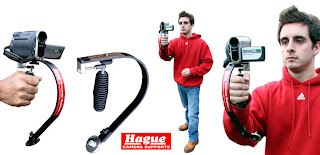I would guess most serious photographers don’t spend their time making videos except for birthdays, Christmas and perhaps two weeks in the sun every year. But if making a video is as easy as taking a photo, could you resist the temptation to give it a go?
As someone who’s spent a lot of time making photography videos over the past year, I’ve had to learn video skills the hard way. That meant starting with the real basics such as how to keep the camera still.
It’s not a problem in photography, you press the button and freeze the scene, but in video the scene goes on and on and on. Unless you want to make your audience sea sick you’ll need to keep your camera still and your movements steady.
I use one of three techniques.
 You already know the value of using a decent tripod when it comes to getting sharp photo’s, so it’s no surprise that a tripod will also deliver steady videos, but for portability a monopod is hard to beat. I use a Hama Star 08 which is perfect for my little camcorder, it’s a bit too flimsy for a DSLR. A more heavy duty monopod shouldn’t be expensive and is a great addition to any photographer’s kit bag.
You already know the value of using a decent tripod when it comes to getting sharp photo’s, so it’s no surprise that a tripod will also deliver steady videos, but for portability a monopod is hard to beat. I use a Hama Star 08 which is perfect for my little camcorder, it’s a bit too flimsy for a DSLR. A more heavy duty monopod shouldn’t be expensive and is a great addition to any photographer’s kit bag.Next up is a Steadicam. I use the Mini motion cam from Hague. It’s a low tech solution to the problem of smoothing jerky movements such as walking. The whole system relies on small weights at the bottom which counterbalances the camera on the top. It really works, but takes a bit of practice.

The final solution is fairly new to me, but it’s one I hope will greatly improve my videos. To really keep things smooth I’m playing with a piece of video software called Virtualdub and specifically a filter called DeShaker. The filter does exactly what it says. Watch this short clip to see the before and after effect. Amazingly this software is 100% free.
It would appear that the line between a photography and videographer is likely to blur over the next few years. You can choose to ignore it, or embrace it. If you don’t want to get left behind, I’d recommend you consider the later and soon.

3 comments:
Great post.
I've recently bought a Samsung R10 Camcorder. Its nice and small and fits in my backpack without taking up much room. It has electronic stablisation which is ok but any movement tends to be a bit jerky.
Hopefully the Virtual Dub/Deshaker combo will help me out.
Darryl. Virtualdub has a learning curve and a few quirks. For example it only handles AVI files by default. I found DivX was the best format to use.
I've now run a whole 15 minute challenge through DeShaker. The results are a vast improvement on the hand held footage.
Gavin, I can't thank you enough for your tutorials. Your tips have been so helpful. Things that I didn't even know existed in Photoshop. Shirley
Post a Comment